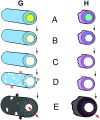Nanoscale analysis of pyritized microfossils reveals differential heterotrophic consumption in the ~1.9-Ga Gunflint chert
- PMID: 23630257
- PMCID: PMC3657779
- DOI: 10.1073/pnas.1221965110
Nanoscale analysis of pyritized microfossils reveals differential heterotrophic consumption in the ~1.9-Ga Gunflint chert
Abstract
The 1.88-Ga Gunflint biota is one of the most famous Precambrian microfossil lagerstätten and provides a key record of the biosphere at a time of changing oceanic redox structure and chemistry. Here, we report on pyritized replicas of the iconic autotrophic Gunflintia-Huroniospora microfossil assemblage from the Schreiber Locality, Canada, that help capture a view through multiple trophic levels in a Paleoproterozoic ecosystem. Nanoscale analysis of pyritic Gunflintia (sheaths) and Huroniospora (cysts) reveals differing relic carbon and nitrogen distributions caused by contrasting spectra of decay and pyritization between taxa, reflecting in part their primary organic compositions. In situ sulfur isotope measurements from individual microfossils (δ(34)S(V-CDT) +6.7‰ to +21.5‰) show that pyritization was mediated by sulfate-reducing microbes within sediment pore waters whose sulfate ion concentrations rapidly became depleted, owing to occlusion of pore space by coeval silicification. Three-dimensional nanotomography reveals additional pyritized biomaterial, including hollow, cellular epibionts and extracellular polymeric substances, showing a preference for attachment to Gunflintia over Huroniospora and interpreted as components of a saprophytic heterotrophic, decomposing community. This work also extends the record of remarkable biological preservation in pyrite back to the Paleoproterozoic and provides criteria to assess the authenticity of even older pyritized microstructures that may represent some of the earliest evidence for life on our planet.
Keywords: biogeochemistry; paleontology; taphonomy.
Conflict of interest statement
The authors declare no conflict of interest.
Figures





References
-
- Gehling JG. Microbial mats in terminal Proterozoic siliciclastics: Ediacaran deathmasks. Palaios. 1999;14(1):40–57.
-
- Laflamme M, Schiffbauer JD, Narbonne GM, Briggs DEG. Microbial biofilms and the preservation of the Ediacara biota. Lethaia. 2011;44(2):203–213.
-
- Allison PA, Briggs DEG. 1991. Tissues. Taphonomy: Releasing the Data Locked in the Fossil Record, eds Allison PA, Briggs DEG (Plenum, New York), pp 25–69.
-
- Briggs DEG, Bottrell SH, Raiswell R. Pyritisation of soft-bodied fossils: Beecher’s Trilobite Bed, Upper Ordovician, New York State. Geology. 1991;19(12):1221–1224.
-
- Briggs DEG, Raiswell R, Bottrell SH, Hatfield D, Bartels C. Controls on the pyritization of exceptionally preserved fossils: An analysis of the Lower Devonian Hunsruck Slate of Germany. Am J Sci. 1996;296(6):633–663.
Publication types
MeSH terms
Substances
LinkOut - more resources
Full Text Sources
Other Literature Sources

